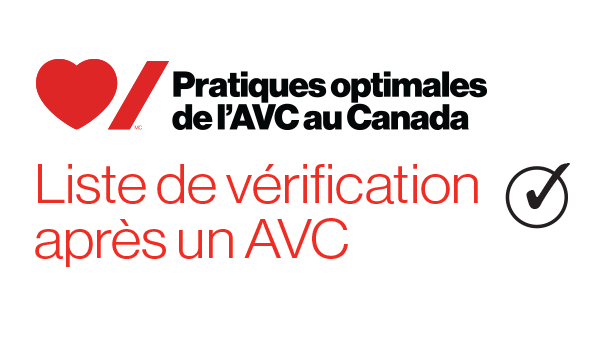Recommandations
Ces recommandations sont spécifiques aux patients présentant une hémorragie intracérébrale (HI) et doivent être prises en compte en complément de la prise en charge de l’AVC en phase aiguë en milieu hospitalier telle que définie dans le chapitre le plus récent sur la prise en charge de l’AVC en phase aiguë des Recommandations.
2.0 Soins hospitaliers à la suite d’une hémorragie intracérébrale
- Les patients présentant une HI en phase aiguë dont l’état de santé est stable doivent être admis dans une unité de prise en charge de l’AVC en phase aiguë ou une unité de soins intensifs neurologiques [niveau de données probantes B], et subir une évaluation par une équipe interprofessionnelle de prise en charge de l’AVC afin de déterminer leurs besoins en matière de réadaptation et d’autres soins [niveau de données probantes B]. Voir la section 8 du chapitre sur la prise en charge de l’AVC en phase aiguë des Recommandations pour de plus amples renseignements (ajouter le lien). Voir le chapitre sur la réadaptation et le rétablissement après un AVC des Recommandations pour de plus amples renseignements sur l’évaluation des besoins en matière de réadaptation.
- Les objectifs en matière de soins et de rétablissement doivent être établis avec le patient ou le mandataire spécial désigné [niveau de données probantes B].
- Le pronostic pour la modification des objectifs en matière de soins doit généralement être différé de 48 à 72 heures après la présentation, afin de déterminer l’étendue des déficits, la réponse au traitement médical et le potentiel d’aggravation de l’état [niveau de données probantes B]. Voir la section 10 sur les soins palliatifs du chapitre sur la prise en charge de l’AVC en phase aiguë des Recommandations pour de plus amples renseignements.
- Les exceptions au report du pronostic et aux objectifs en matière de soins conservateurs peuvent concerner des patients qui ont préalablement affirmé vouloir éviter les traitements invasifs de maintien des fonctions vitales en raison de comorbidités (p. ex., la démence) ou sur la base de leurs propres valeurs exprimées précédemment [niveau de données probantes C].
2.1 Prophylaxie de la thromboembolie veineuse
- Dans la phase aiguë de l’HI, les patients doivent être mis sous dispositifs de compression pneumatique intermittente dès le jour de leur admission [niveau de données probantes A].
- Les bas de compression gradués ne sont pas recommandés pour la prévention de la TVP [niveau de données probantes A].
- La chimioprophylaxie (héparine de faible poids moléculaire) peut être initiée après 48 heures et après la documentation de la stabilisation de l’hématome sur la neuro-imagerie [niveau de données probantes B].
- La documentation de la stabilisation de l’hématome nécessite une TDM, au minimum 24 heures après la TDM initiale.
2.2 Prise en charge des convulsions
- Les personnes présentant une HI courent un plus grand risque de convulsions lors de la présentation [niveau de données probantes B] et doivent faire l’objet d’un suivi clinique.
- On peut envisager un électroencéphalogramme continu pour le diagnostic de l’état de mal épileptique non convulsif chez les patients présentant une dépression du niveau de conscience disproportionnée par rapport à la taille et à l’emplacement de l’HI [niveau de données probantes B].
- Les convulsions d’apparition récente chez les patients admis à l’hôpital présentant une HI doivent être traitées à l’aide de médicaments antiépileptiques si elles ne disparaissent pas spontanément [niveau de données probantes C].
- Un épisode unique d’épilepsie au début des symptômes de l’HI ou moins de 24 heures après une HI (considéré comme une épilepsie « immédiate » après un AVC) et qui disparaît spontanément ne doit pas être traité avec un anticonvulsivant à action de longue durée [niveau de données probantes C]. Dans ces cas, un traitement anticonvulsivant à action de courte durée peut être envisagé sur une base individuelle [niveau de données probantes C].
- Les patients victimes d’une crise d’épilepsie immédiate après une HI doivent être suivis en vue de déterminer les possibles récidives en surveillant les signes vitaux et l’état neurologique. Les récidives d’épilepsie chez les patients présentant une HI doivent être traitées conformément aux recommandations pour les soins de l’épilepsie dans d’autres troubles neurologiques [niveau de données probantes C].
- L’utilisation prophylactique d’anticonvulsivants pour les patients présentant une HI n’est pas recommandée [niveau de données probantes B].
2.3 Augmentation de la pression intracrânienne
- En cas d’augmentation suspectée de la pression intracrânienne (PIC), les méthodes conservatives de diminution de la PIC (comme l’élévation de la tête du lit à 30 degrés, les méthodes de neuroprotection comme l’euthermie et l’euglycémie, l’analgésie et une sédation moyenne) sont des mesures raisonnables [niveau de données probantes C].
- En l’absence de préoccupations concernant la PIC, le positionnement de la tête du lit ne semble pas influencer l’évolution neurologique ou les événements indésirables graves chez les patients ayant subi un AVC, y compris l’HI [niveau de données probantes B].
- Il n’y a pas suffisamment de données probantes pour recommander l’utilisation systématique ou prophylactique des agents hyperosmotiques pour le traitement de l’HI [niveau de données probantes C].
- L’utilisation de corticostéroïdes pour traiter la PIC dans un cas d’HI peut entraîner des dommages et n’a pas de bénéfices prouvés. Par conséquent, elle n’est pas recommandée [niveau de données probantes B].
Facteurs cliniques pour la section 2.3
- L’hyperthermie et l’hyperglycémie ont été associées à de mauvais résultats chez les patients présentant une HI. En l’absence de données probantes issues d’essais cliniques randomisés, il est conseillé d’avoir pour objectif la normothermie et la normoglycémie chez les patients hospitalisés pour une HI.
- Chez les patients ayant une PIC élevée, il faut veiller à éviter la compression des vaisseaux du cou, en particulier lors de la fixation des tubes endotrachéaux.
2.4 Réadaptation après une hémorragie intracérébrale
Remarque : L’évaluation et la prise en charge de la réadaptation pour les personnes présentant une HI suivent généralement les mêmes approches que pour les personnes ayant subi un AVC provoqué par d’autres causes. Par conséquent, les recommandations contenues dans le chapitre sur la réadaptation et le rétablissement après un AVC des Recommandations s’appliquent à cette population de patients. Cela inclut une évaluation précoce pendant les soins aigus hospitaliers.
- L’état de préparation pour la réadaptation des patients présentant une HI devrait faire l’objet d’une surveillance continue au-delà des délais conventionnels utilisés pour les patients victimes d’un AVC ischémique, en raison des données probantes émergentes concernant leur période de rétablissement prolongée [niveau de données probantes B].
Remarque : Les évaluations précoces de l’état de préparation pour la réadaptation peuvent sous-estimer le potentiel de réadaptation.
Les soins en unité de prise en charge de l’AVC réduisent la probabilité de décès et d’invalidité jusqu’à 30 % pour les hommes et les femmes de tout âge ayant subi un AVC léger, modéré ou grave. Les soins en unité de prise en charge de l’AVC se caractérisent par une approche coordonnée d’équipe interdisciplinaire pour prévenir les complications liées à l’AVC, empêcher la récidive de l’AVC, accélérer la mobilisation et fournir des traitements de réadaptation précoces. Les données probantes suggèrent que les patients traités dans des unités de prise en charge de l’AVC en phase aiguë présentent moins de complications et sont mobilisés plus tôt; de plus, la pneumonie est détectée plus rapidement. Les patients doivent être traités dans une unité située dans un lieu bien défini, car les soins dispensés dans des séquences de prise en charge de l’AVC par des équipes itinérantes de prise en charge de l’AVC ne présentent pas les mêmes avantages. L’accès à une réadaptation précoce est un aspect essentiel des soins en unité de prise en charge de l’AVC. Pour les patients ayant subi un AVC, la réadaptation doit commencer le plus tôt possible et celle-ci doit être considérée comme une intervention qui peut avoir lieu dans n’importe quel milieu dans tout le continuum de soins de l’AVC.
- Systèmes organisés de soins de l’AVC, y compris des unités de prise en charge de l’AVC disposant d’un bassin important de personnel formé (équipe interdisciplinaire). Si ce n’est pas possible, mise en place de mécanismes de coordination des soins aux patients ayant subi un AVC pour garantir le recours à des pratiques exemplaires et assurer des résultats optimaux
- Protocoles et mécanismes permettant le transfert rapide des patients ayant subi un AVC dû à une HI du service des urgences à une unité spécialisée de prise en charge de l’AVC dès que possible après leur arrivée à l’hôpital, idéalement dans les six premières heures
- Centres de soins intégrés et avancés de l’AVC jouant un rôle de premier plan dans leur région géographique afin de garantir l’accès aux soins spécialisés de l’AVC pour les patients qui peuvent se présenter d’abord dans des établissements de soins généraux (généralement des centres dans des régions éloignées ou rurales) et des établissements offrant uniquement des services de base pour la prise en charge de l’AVC
- Infrastructure et utilisation des services de télé-AVC optimisées afin de garantir l’accès à des soins spécialisés de l’AVC tout au long du continuum pour répondre aux besoins individuels (y compris l’accès à des spécialistes de la réadaptation et de l’AVC), notamment les besoins des résidents des régions nordiques, rurales et éloignées du Canada
- Informations sur l’emplacement géographique des unités de prise en charge de l’AVC et d’autres modèles de soins spécialisés de l’AVC disponibles pour les prestataires de services communautaires, afin de faciliter la navigation vers les ressources appropriées et de renforcer les relations entre chaque secteur tout au long du continuum de soins de l’AVC
Indicateurs de rendement au niveau du système
- Proportion de patients présentant une HI traités dans un centre de soins de l’AVC de niveau 4 ou 5
Indicateurs de rendement clinique
- Nombre de patients présentant une HI qui sont admis à l’hôpital et traités dans une unité spécialisée de prise en charge de l’AVC à n’importe quel moment de leur séjour à l’hôpital pour un AVC en phase aiguë (numérateur) par rapport au nombre total de patients ayant subi un AVC admis à l’hôpital (base)
- Proportion de patients présentant une HI qui décèdent à l’hôpital dans les 7 jours et dans les 30 jours après leur admission pour l’AVC de référence (base)
- Proportion du temps passé dans une unité de prise en charge de l’AVC par rapport au temps total passé à l’hôpital pour une HI aiguë
- Proportion de patients admis dans une unité de prise en charge de l’AVC qui arrivent à l’unité dans les 24 heures suivant leur arrivée au service des urgences
- Pourcentage de patients admis à l’hôpital en raison d’un diagnostic d’AVC en phase aiguë, qui éprouvent une complication ou plus pendant leur hospitalisation (thrombose veineuse profonde, embolie pulmonaire, hémorragie cérébrale secondaire, saignement gastro-intestinal, ulcères de pression, infection urinaire, pneumonie, crises [ou convulsions])
- Durée médiane du séjour en soins de courte durée pour les patients présentant une HI admis à l’hôpital (base) [stratifier par type d’AVC]
- Pourcentage de patients présentant une HI dont le séjour a été prolongé au-delà de la durée attendue en raison d’une ou de plusieurs complications
- Pourcentage de patients présentant une HI qui ont été orientés vers des services de soins palliatifs spécialisés pendant leur hospitalisation
- Pourcentage de patients mourants présentant une HI qui ont été placés sous un protocole de soins de fin de vie
- Pourcentage de patients présentant une HI qui décèdent dans le lieu précisé dans leur plan de soins palliatifs
Indicateurs de rendement des résultats axés sur le patient
- Qualité de vie autoévaluée après une HI à l’aide d’un outil de mesure validé
- Proportion de patients présentant une HI qui ont été renvoyés à leur domicile ou lieu de résidence après avoir été hospitalisés pour un AVC (base)
- Évaluations des familles et des aidants sur l’expérience des soins palliatifs après le décès à l’hôpital d’un patient présentant une HI
Notes relatives à la mesure des indicateurs
- Les centres de niveau 4 et 5 qui respectent les critères des pratiques optimales comprennent une unité de prise en charge de l’AVC et des services de neurochirurgie accessibles sur place.
Renseignements destinés aux fournisseurs de soins de santé
- CoHESIVE (en anglais seulement)
- Stroke Engine
- Trousse de soins de santé virtuels 2020
- Lignes directrices pour l’anticoagulation de l’American College of Chest Physicians (ACCP) (en anglais seulement)
- Lignes directrices d’Hypertension Canada
- Tableau 2B des Recommandations canadiennes pour les pratiques optimales de soins de l’AVC : « Épreuves de laboratoire recommandées pour un AVC en phase aiguë et un AIT ».
- Annexe 3 des pratiques optimales de soins de l’AVC : Outils de dépistage et d’évaluation de la gravité de l’AVC
Informations destinées aux personnes ayant subi un AVC, à leur famille et à leurs aidants
- Stroke Engine
- Liste de contrôle post-AVC
- Votre cheminement après un AVC
- L’AVC chez les jeunes adultes
- Répertoire des ressources de l’AVC
- Prendre en main son rétablissement : fiche d’information sur la réadaptation et le rétablissement
- Prendre en main son rétablissement : fiche d’information sur les transitions et la participation communautaire
- Prendre en main son rétablissement : aide-mémoire pour les soins de santé virtuels 2020
- Ressources pour les patients d'Hypertension Canada
- Fondation des maladies du cœur et de l'AVC- Partenariat canadien pour le rétablissement de l’AVC
Lien vers les tableaux de données probantes et la liste des références (en anglais)
Specialized Units
While it is now well-accepted that patients with ischemic stroke admitted to a stroke unit featuring dedicated beds and staff have better outcomes compared with patients admitted to general or less-specialized units, there is also evidence that the subset of patients who have experienced ICH realize the same benefits. In a systematic review, Langhorne et al (2013) included the results from 8 trials in which patients with ischemic and hemorrhagic stroke were randomized to receive care on a stroke unit or an alternative setting. Stroke unit care was associated with significant reductions in the risk of death or dependency (mRS 3-5) (RR=0.81, 95% CI 0.71-0.92, p<0.0001) and death (RR=0.79, 95% CI 0.64-0.97, p=0.02), with no significant interactions based on stroke type. Diringer & Edwards (2001) reviewed the charts of 1,038 patients who had been admitted to either a neuro-ICU (n=2) or a medical and/or surgical ICU (n=40) following ICH and reported that after adjusting for demographics, severity of ICH, and ICU and institutional characteristics, admission to a general ICU was associated with an increase in hospital mortality (OR=3.4; 95% CI 1.65–7.6). Additional independent predictors of higher mortality were advancing age, lower GCS scores, fewer ICH patients treated and smaller ICU size. In contrast, having a full-time intensivist was associated with lower mortality rate. Ronning et al. (2001) also reported improved survival during the first 30 days and one year following admittance to an acute stroke unit care. At 30 days, fewer patients in the stroke unit group were dead (39% vs. 63%, adjusted OR=0.40, 95% CI 0.17-0.94). There was no difference in one-year mortality between groups (52% vs. 69%, adjusted OR=0.58, 95% CI 0.24-1.38), or the number of patients discharged home between groups (27% vs. 52%, adjusted OR=1.60, 95% 0.62-4.00).
Venous Thromboembolism (VTE) Prophylaxis
The use of external compression stockings/devices was investigated in a series of three large, related RCTs, the Clots in Legs Or sTockings after Stroke (CLOTS) trials. In the third trial, CLOTS 3 (Dennis et al. 2013), patients were randomized to a wear thigh length intermittent pneumatic compression (IPC) device or to no IPC for a minimum of 30 days. Of the 2,876 patients included, 13% had suffered an ICH. The mean duration of IPC use was 12.5 days and 100% adherence to treatment was achieved in only 31% in the IPC group. The incidence of proximal DVT within 30 days was significantly lower for patients in the IPC group (8.5% vs. 12.1%, OR=0.65, 95% CI 0.51-0.84, p=0.001, ARR=3.6%, 95% CI 1.4%-5.8%). There were no significant differences between groups for the outcomes of: death at 30 days (10.8% vs. 13.1%, p=0.057), symptomatic proximal DVT (2.7% vs. 3.4%, p=0.269), or pulmonary embolism (2.0% vs. 2.4%, p=0.453). The incidence of any DVT (symptomatic, asymptomatic, proximal or calf) was significantly lower for IPC group (16.2% vs. 21.1%, OR=0.72, 95% CI 0.60-0.87, p=0.001). At 6 months, the incidence of any DVT remained significantly lower in the IPC group (16.7% vs. 21.7%, OR=0.72, 95% CI 0.60-0.87, p=0.001). The incidence of any DVT, death or PE also remained significantly lower for IPC group (36.6% vs. 43.5%, OR=0.74, 95% CI 0.63-0.86, p<0.0001). In a systematic review and meta-analysis, Paciaroni et al. (2011) reported that early treatment with UFH and LMWH initiated between 1-6 days following ICH led to a significant reduction in the incidence of pulmonary embolus (1.7% vs. 2.9%; P = 0.01), without an increase in hematoma expansion. In a small randomized trial of 68 patients with ICH, participants randomized to LWMH on day 2 following their ICH experienced fewer pulmonary emboli than those randomized to initiate treatment on days 4 and 10, without an apparent increase in rebleeding (Boeer et al. 1991).
Seizure Management
Following ICH, patients are at increased risk of seizures. Early-onset seizure typically occur at or near event onset, and are thought to be less common, while late-onset seizures occur 6-12 months post event. Whether to treat a first occurrence of a post stroke seizure following an ICH, is a topic of debate. Individual patient risk factors should be considered. However, long-term use of antiepileptic drugs (AED) has not been shown to be effective at reducing the odds of recurrent seizure (Angriman et al. 2019), and may be associated with poor outcome (Messe et al. 2009). There are very few studies that have the use of AEDs in stroke, generally and following ICH, specifically.
Increased Intracranial Pressure
While a wide variety of nonsurgical interventions are used commonly to lower intracranial pressure following ICH, including head elevation, hyperosmotic agents, hyperventilation, analgesia, and sedation, RCT evidence of their effectiveness is lacking. Head‑ PoST (Anderson et al. 2017) randomized over 11,000 patients following stroke to receive care in either a lying-flat position or a sitting-up position with the head elevated to at least 30 degrees, which was initiated as soon as possible and maintained for 24 hours). There were no significant differences between groups in any of the primary or secondary clinical outcomes (mRS scores, death or major disability at 7 and 90 days). The results were similar in the subgroup of 8% of patients with ICH.






